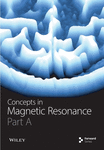Solving the fractional order Bloch equation
Abstract
Nuclear magnetic resonance (NMR) is a physical phenomenon widely used in chemistry, medicine, and engineering to study complex materials. NMR is governed by the Bloch equation, which relates a macroscopic model of magnetization to applied radiofrequency, gradient and static magnetic fields. Simple models of materials are well described by the classical first order dynamics of precession and relaxation inherent in the vector form of the Bloch equation. Fractional order generalization of the Bloch equation presents an opportunity to extend its use to describe a wider range of experimental situations involving heterogeneous, porous, or composite materials. Here we describe the generalization of the Bloch equation in terms of Caputo fractional derivatives of order α (0 < α < 1) for a single spin system in a static magnetic field at resonance. The results are expressed in terms of the Mittag–Leffler function—a generalized exponential function that converges to the classical case when α = 1. © 2009 Wiley Periodicals, Inc. Concepts Magn Reson Part A 34A: 16–23, 2009.




